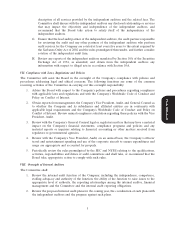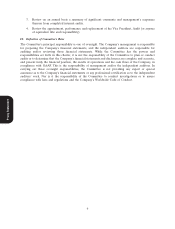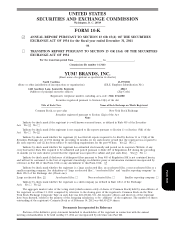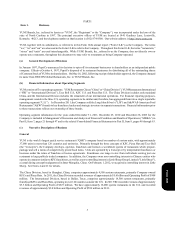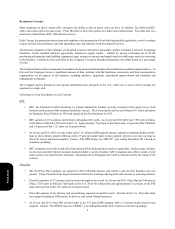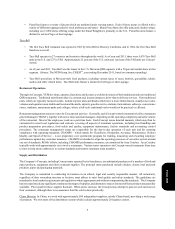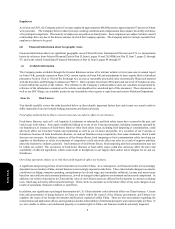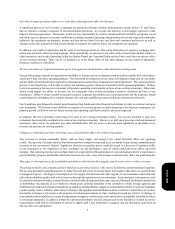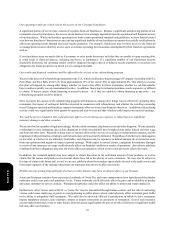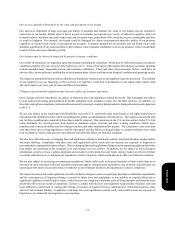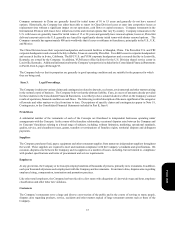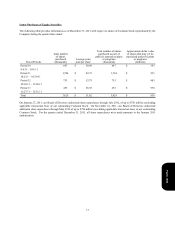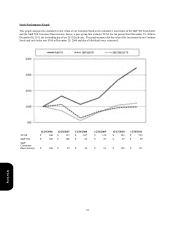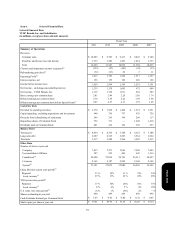Pizza Hut 2011 Annual Report Download - page 113
Download and view the complete annual report
Please find page 113 of the 2011 Pizza Hut annual report below. You can navigate through the pages in the report by either clicking on the pages listed below, or by using the keyword search tool below to find specific information within the annual report.
9
Our other foreign operations subject us to risks that could negatively affect our business.
A significant portion of our Concepts’ restaurants are operated in foreign countries and territories outside of the U.S. and China,
and we intend to continue expansion of our international operations. As a result, our business is increasingly exposed to risks
inherent in foreign operations. These risks, which can vary substantially by country, include political instability, corruption, social
and ethnic unrest, changes in economic conditions (including consumer spending, unemployment levels and wage and commodity
inflation), the regulatory environment, income and non-income based tax rates and laws and consumer preferences as well as
changes in the laws and policies that govern foreign investment in countries where our restaurants are operated.
In addition, our results of operations and the value of our foreign assets are affected by fluctuations in currency exchange rates,
which may adversely affect reported earnings. More specifically, an increase in the value of the United States Dollar relative to
other currencies, such as the Australian Dollar, the British Pound, the Canadian Dollar and the Euro, could have an adverse effect
on our reported earnings. There can be no assurance as to the future effect of any such changes on our results of operations,
financial condition or cash flows.
We may not attain our target development goals, and aggressive development could cannibalize existing sales.
Our growth strategy depends in large part on our ability to increase our net restaurant count in markets outside the United States,
especially China and other emerging markets. The successful development of new units will depend in large part on our ability
and the ability of our franchisees to open new restaurants and to operate these restaurants on a profitable basis. We cannot guarantee
that we, or our franchisees, will be able to achieve our expansion goals or that new restaurants will be operated profitably. Further,
there is no assurance that any new restaurant will produce operating results similar to those of our existing restaurants. Other risks
which could impact our ability to increase our net restaurant count include prevailing economic conditions and our, or our
franchisees’, ability to obtain suitable restaurant locations, negotiate acceptable lease or purchase terms for the locations, obtain
required permits and approvals in a timely manner, hire and train qualified personnel and meet construction schedules.
Our franchisees also frequently depend upon financing from banks and other financial institutions in order to construct and open
new restaurants. If it becomes more difficult or expensive for our franchisees to obtain financing to develop new restaurants, our
planned growth could slow and our future revenue and operating cash flows could be adversely impacted.
In addition, the new restaurants could impact the sales of our existing restaurants nearby. It is not our intention to open new
restaurants that materially cannibalize the sales of our existing restaurants. However, as with most growing retail and restaurant
operations, there can be no assurance that sales cannibalization will not occur or become more significant in the future as we
increase our presence in existing markets.
Changes in commodity and other operating costs could adversely affect our results of operations.
Any increase in certain commodity prices, such as food, supply and energy costs, could adversely affect our operating
results. Because our Concepts and their franchisees provide competitively priced food, our ability to pass along commodity price
increases to our customers is limited. Significant increases in gasoline prices could also result in a decrease of customer traffic
at our restaurants or the imposition of fuel surcharges by our distributors, each of which could adversely affect our profit
margins. Our operating expenses also include employee wages and benefits and insurance costs (including workers’ compensation,
general liability, property and health) which may increase over time. Any such increase could adversely affect our profit margins.
Shortages or interruptions in the availability and delivery of food and other supplies may increase costs or reduce revenues.
The products sold by our Concepts and their franchisees are sourced from a wide variety of domestic and international suppliers.
We are also dependent upon third parties to make frequent deliveries of food products and supplies that meet our specifications
at competitive prices. Shortages or interruptions in the supply of food items and other supplies to our restaurants could adversely
affect the availability, quality and cost of items we buy and the operations of our restaurants. Such shortages or disruptions could
be caused by inclement weather, natural disasters such as floods, drought and hurricanes, increased demand, problems in production
or distribution, the inability of our vendors to obtain credit, political instability in the countries in which foreign suppliers and
distributors are located, the financial instability of suppliers and distributors, suppliers' or distributors' failure to meet our standards,
product quality issues, inflation, other factors relating to the suppliers and distributors and the countries in which they are located,
food safety warnings or advisories or the prospect of such pronouncements or other conditions beyond our control. A shortage or
interruption in the availability of certain food products or supplies could increase costs and limit the availability of products critical
to restaurant operations. In addition, failure by a principal distributor for our Concepts and/or our franchisees to meet its service
requirements could lead to a disruption of service or supply until a new distributor is engaged, and any disruption could have an
adverse effect on our business.
Form 10-K


